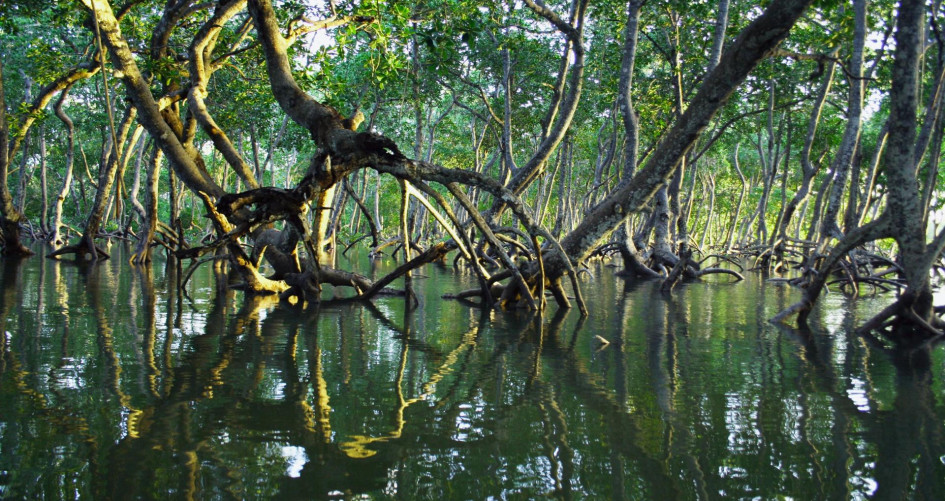Nature-based Solutions is a term first coined in 2009 by the World Bank and the International Union for Conservation of Nature (IUCN) – it refers to actions that protect, sustainably manage, and restore natural or modified ecosystems, that address societal challenges effectively and adaptively, simultaneously providing human well-being and biodiversity benefits. These solutions can range from planting forests and mangroves to restoring coral reefs and peatlands.
The beauty of Nature-based Solutions (NbS) is that they have so many benefits. For example, planting mangrove forests along coastlines has a huge range of positive effects, from providing protective natural barriers against erosion and storms, to filtering water, providing timber and food for local communities, and of course, storing large amounts of carbon.
And it is now well established that biodiversity loss and climate change are both interlinked. As a report published by 50 of the world’s leading biodiversity and climate experts in 2021 said: “Biodiversity loss and climate change are both driven by human economic activities and mutually reinforce each other. Neither will be successfully resolved unless both are tackled together.”
This was also the message from the Bonn Conference side-event, Nature-based Solutions to Climate Change: Unpacking the Potential and Pitfalls, which featured a host of experts.
Debapriya Roy, a UN Climate Change Program Officer at UNFCCC, spoke about the importance of finance, and what is required to mobilise it for NbS. “The investment case needs to be strengthened, so stakeholders understand the benefits of NbS. Governments also need to account for nature in their budgetary systems and increase private sector disclosure of nature-related financial risks,” she said. Roy also pointed out the issues with access to finance.
“There is funding out there but the requirements to access it are often too complex.” This ties into the to next issue which is a lack of capacity of recipient countries to access this finance. “[There needs to be] trained individuals to meet the reporting and monitoring requirements, which is often not the case,” she added.
Virginia Young, Director of the International Climate and Forests Programme at the Australian Rainforest Conservation Society, spoke about the challenges with regards to climate policy. “There has been very weak recognition of the value and function of the biodiversity in maintaining ecosystem integrity,” she said. “Ecosystems with high integrity are more stable, more resilient and store carbon more safely for longer, so they are lower risk. If you are thinking of increasing action in land, forest and ecosystems, risk is a critical consideration, and maintaining or restoring the integrity of ecosystems becomes a fundamentally important criteria for judging both mitigation and adaptation effectiveness,” she said.
All the panelists agreed that Nature-based Solutions have become far more prominent in recent years, and the benefits of this approach are finally being taken seriously across the board.
Three Nature-based Solutions
Protecting and restoring coral reefs
As increasing storms and rising sea levels threaten coastal communities around the world, more and more communities are looking at adaptation efforts such as breakwaters and sea walls. Yet one natural solution for some areas of the world lies beneath the waves: coral reefs. One Nature study found that reefs can be even more effective than human-built breakwaters at reducing the height and energy of waves. As tides are pushed higher and further inland, protecting and restoring coral reefs is more effective -and cheaper - way of protecting our coastlines and the people that live on them. While many coastal communities do not have a nearby coral reef, many do: the Nature study stated that 200 million people around the world (in places such as India, Indonesia, and the Philippines) could benefit from coral reef restoration.
Protecting peatlands
Peatlands cover less than three per cent of the world’s surface yet contain more land-based carbon than any other ecosystem, twice as much as the world’s forests combined. Yet, despite this, peatlands are being drained for animal grazing, agriculture, forestry and peat mining. When this happens the stored carbon is released into the atmosphere, which is why degraded peatlands account for five per cent of the global carbon budget. Indeed, a report released during COP26 last year revealed that protecting and restoring peatlands would reduce global greenhouse gas emissions by 800 million metric tonnes per year – equivalent to Germany’s annual emissions.
Growing forests
Forests are a prime example of an effective Nature-based solution. Forests protect against erosion, flooding and landslides, are home to 75 per cent of the world’s bird species and 68 per cent of the world’s mammal species. Forests also remove carbon from the atmosphere and cool the air. Recent research has shown that forests in the Tropics cool the air by as much as one degree. Despite the clear benefits of forests, since 2000, the world has lost 10 per cent of its tree cover. And while a coalition of 142 countries – home to more than 90 per cent of the world’s forests – committed to halting and reversing forest loss and land degradation by 2030, enforcement will be key.
